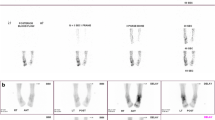Abstract
The most common cause of recurring childhood musculoskeletal pain is termed “growing pains” (GP). The etiology and pathogenesis are unknown. There is an increased prevalence of migraine headaches in families with children with GP. This fact, and the sudden onset and severity of GP episodes, has led to speculation that GP may have a vascular component. Therefore, we investigated whether GP are associated with vascular perfusion changes, measured by technetium-99 methylene diphosphate (MDP) bone scintigraphy. Eleven patients with GP who underwent technetium-99 MDP bone scans were compared to 12 children who underwent bone scans for other indications. The uptake in the blood pool phase, static images, and blood pool phase/static image ratio were measured in the right mid-tibia region (painful among patients with GP) and right mid-femur (non-painful). Student’s t-test was used to compare these measurements at painful and painless regions among GP children, and to compare children with or without GP. There were no significant differences between children with GP and without GP in the blood pool, static images, and blood pool/static images in all localities. There were also no significant differences among patients with GP between painful regions and non-painful regions. We conclude that GP are not associated with vascular perfusion changes in painful regions as opposed to migraine headaches.
Similar content being viewed by others
References
Naish JM, Apley J (1951) “Growing pains”: a clinical study of non-arthritic limb pains in children. Arch Dis Child 26:134–140
Oster J (1972) Recurrent abdominal pain, headache and limb pains in children and adolescents. Pediatrics 50:429–436
Passo MH (1982) Aches and limb pain. Pediatr Clin North Am 29:209–219
Bowyer SL, Hollister JR (1984) Limb pain in childhood. Pediatr Clin North Am 31:1053–1081
Sherry DD, McGuire T, Mellins E, Salmonsen K, Wallace CA, Nepom B (1991) Musculoskeletal pain in childhood: clinical and psychological analysis of 100 children. Pediatrics 88:1093–1099
Manners P (1999) Are growing pains a myth? Aust Fam Physician 28:124–127
Macarthur C, Wright JG, Srivastava R, Rosser W, Feldman W (1996) Variability in physicians’ reported ordering and perceived reassurance value of diagnostic tests in children with growing pains. Arch Pediatr Adolesc Med 150:1072–1076
Aromaa M, Sillanpaa M, Rautava P, Helenius H (2000) Pain experience of children with headache and their families: a controlled study. Pediatrics 106:270–275
Gordon I (1996) Cerebral blood flow imaging in paediatrics: a review. Nucl Med Commun 17:1021–1029
Mirza M, Tutus A, Erdogan F, Kula M, Tomar A, Silov G, Koseoglu E (1998) Interictal SPECT with Tc-99m HMPAO studies in migraine patients. Acta Neurol Belg 98:190–194
Cauchy E, Chetaille E, Lefevre M, Kerelou E, Marsigny B (2000) The role of bone scanning in severe frostbite of the extremities: retrospective study of 88 cases. Eur J Nucl Med 27:497–502
Bhatnagar A, Sarker BB, Sawroop K, Chopra MK, Sinha N, Kashyap R (2002) Diagnosis, characterisation and evaluation of treatment response of frostbite using pertechnetate scintigraphy: a prospective study. Eur J Nucl Med Mol Imaging 29:170–175
Lalonde DH, Williams HB, Rosenthall L, Viloria JB (1984) Circulation, bone scans, and tetracycline labeling in microvascularized and vascular bundle implanted rib grafts. Ann Plast Surg 13:366–374
Al-Nahhas AM, Collins CD, Jawad AS, McCready VR (1994) Reversible findings of methylene diphosphonate bone scintigraphy in Raynaud’s phenomenon: case report and review of the literature. Eur J Nucl Med 21:258–260
Hoffman J, Phillips W, Blum M, Barohn R, Ramamurthy S (1993) Effect of sympathetic block demonstrated by triple-phase bone scan. J Hand Surg 18:860–864
Grahame R, Bird HA, Child A (2000) The revised (Brighton 1998) criteria for the diagnosis of benign joint hypermobility syndrome (BJHS). J Rheumatol 27:1777–1779
Spina A, Damato V, Losita R, Marzocco P, Narducci P, Zizzo L (1992) Brain SPECT and migraine in childhood. Acta Neurol 14:10–14
Lagreze HL, Dettmers C, Hartmann A (1988) Abnormalities of interictal cerebral perfusion in classic but not common migraine. Stroke 19:1108–1111
Aksoy FG, Lev MH (2000) Dynamic contrast-enhanced brain perfusion imaging: technique and clinical applications. Semin Ultrasound CT MR 21:462–477
Acknowledgments
We thank Omar Hamza for his technical assistance in the reading of the scans.
Author information
Authors and Affiliations
Corresponding author
Rights and permissions
About this article
Cite this article
Hashkes, P.J., Gorenberg, M., Oren, V. et al. “Growing pains” in children are not associated with changes in vascular perfusion patterns in painful regions. Clin Rheumatol 24, 342–345 (2005). https://doi.org/10.1007/s10067-004-1029-x
Received:
Accepted:
Published:
Issue Date:
DOI: https://doi.org/10.1007/s10067-004-1029-x




